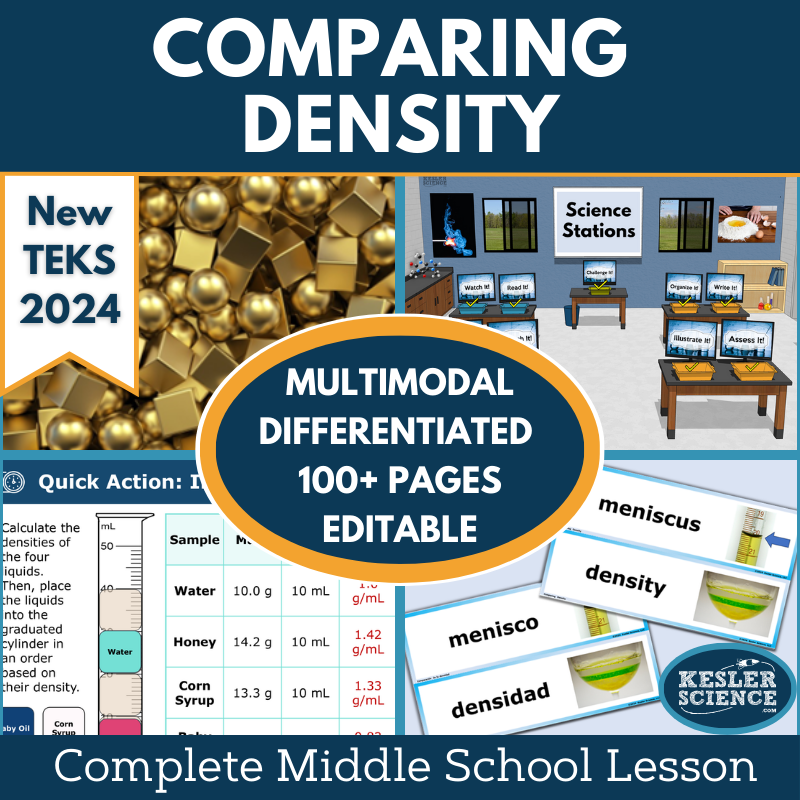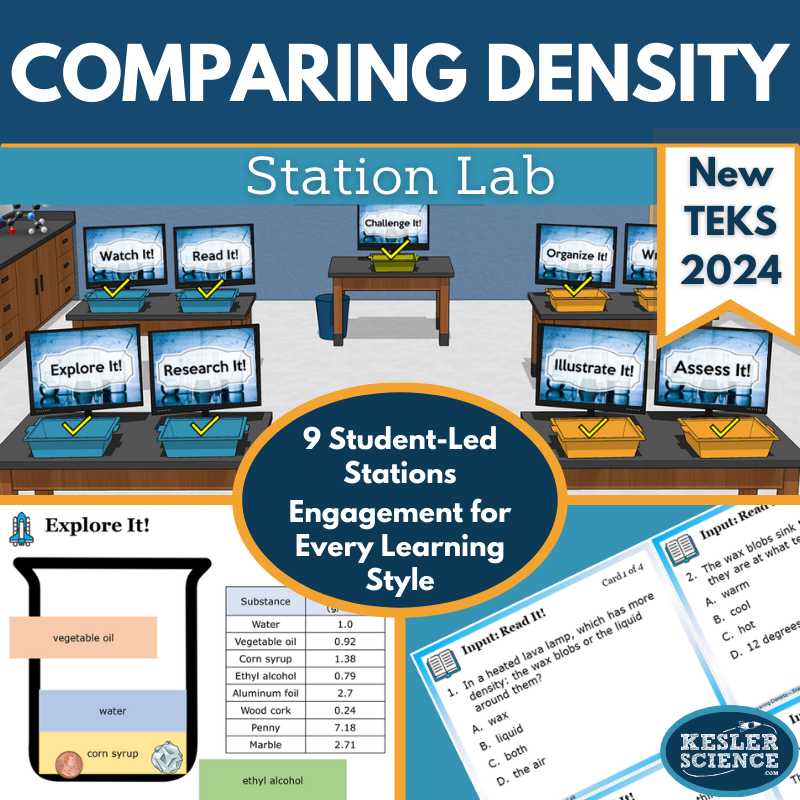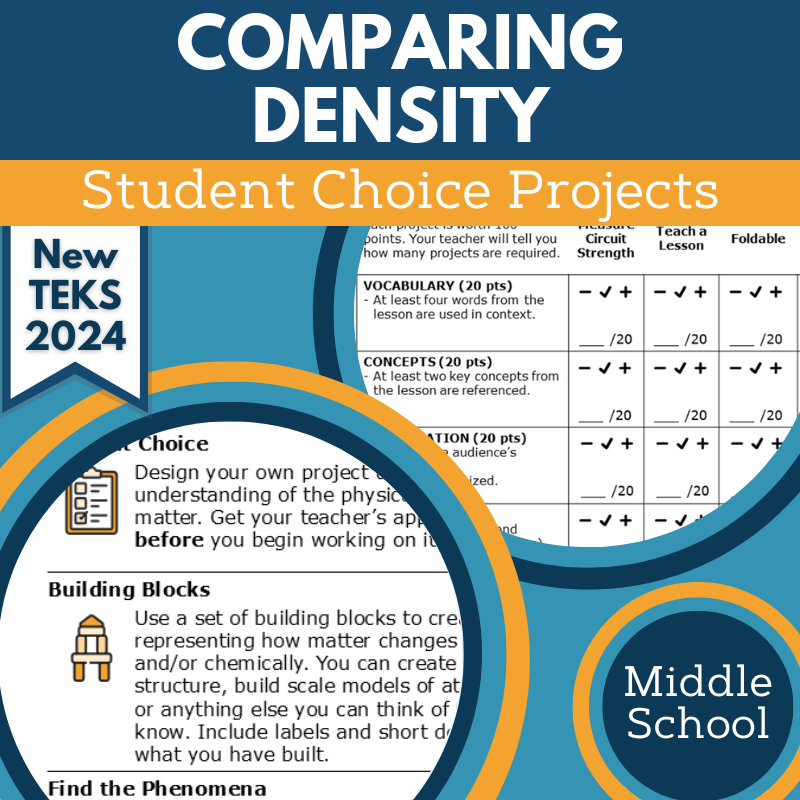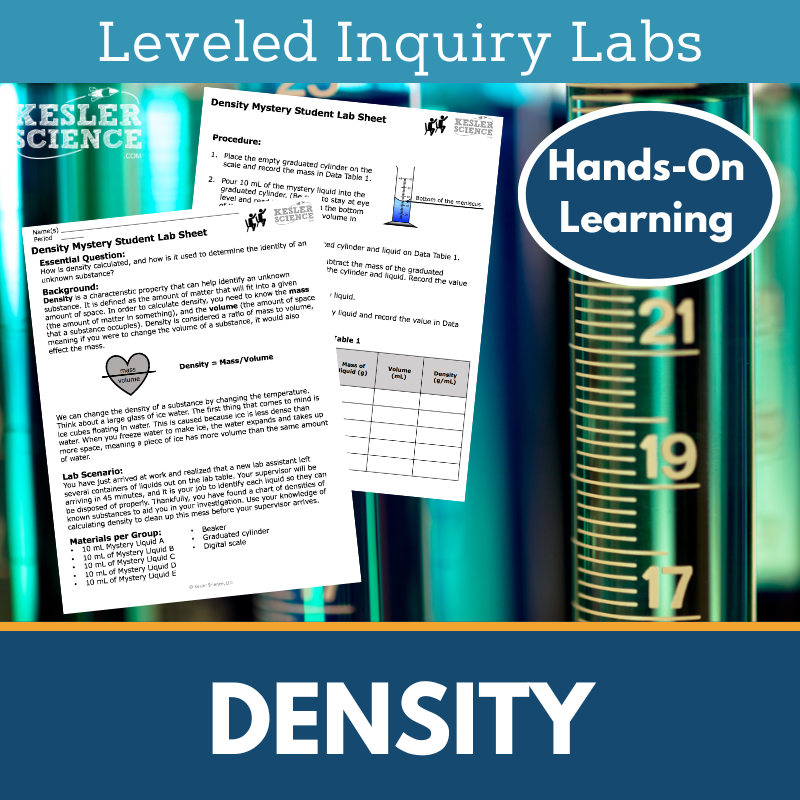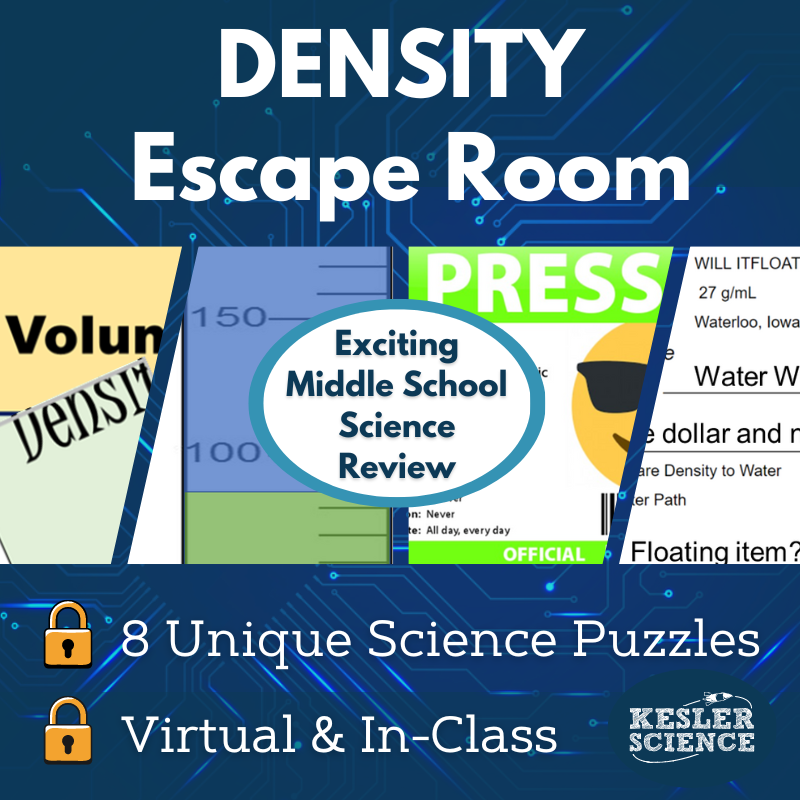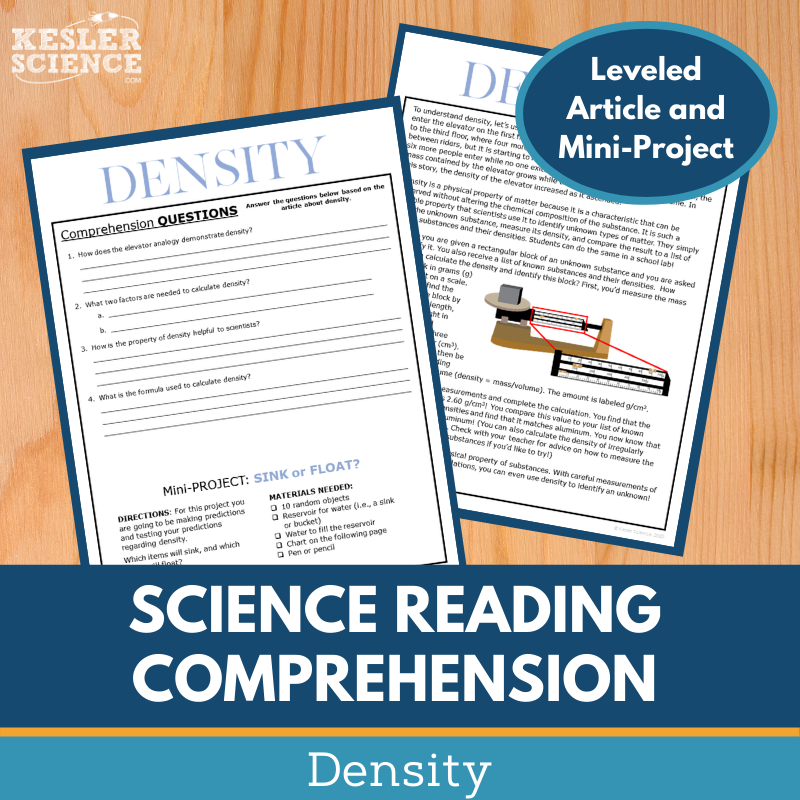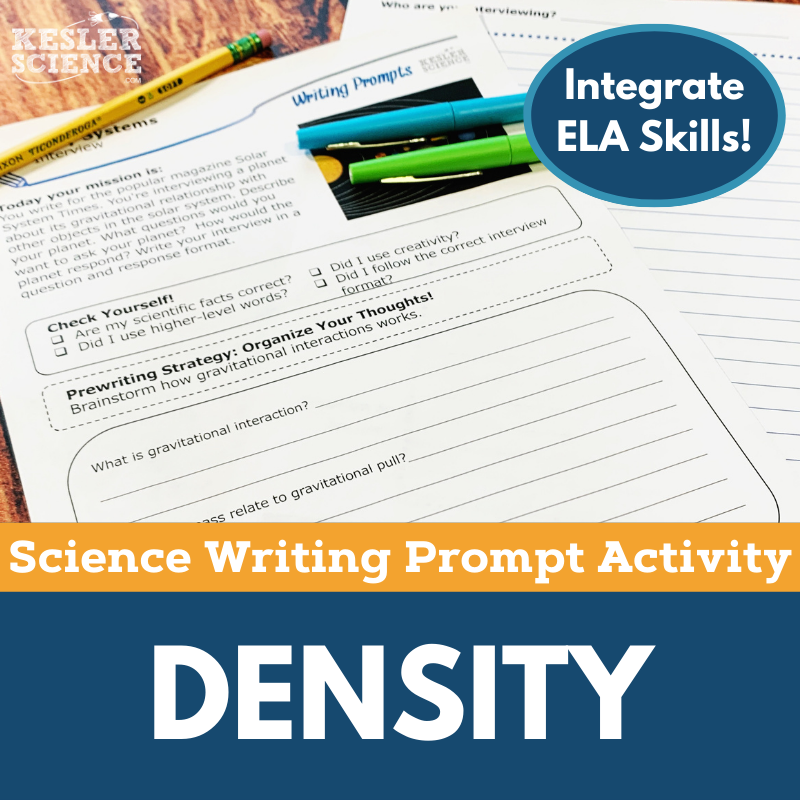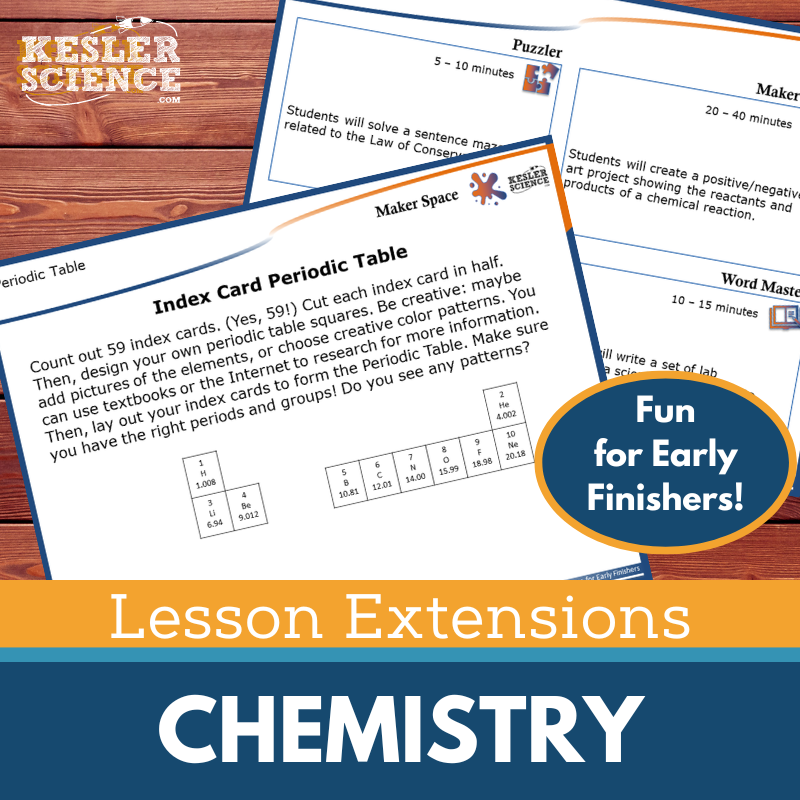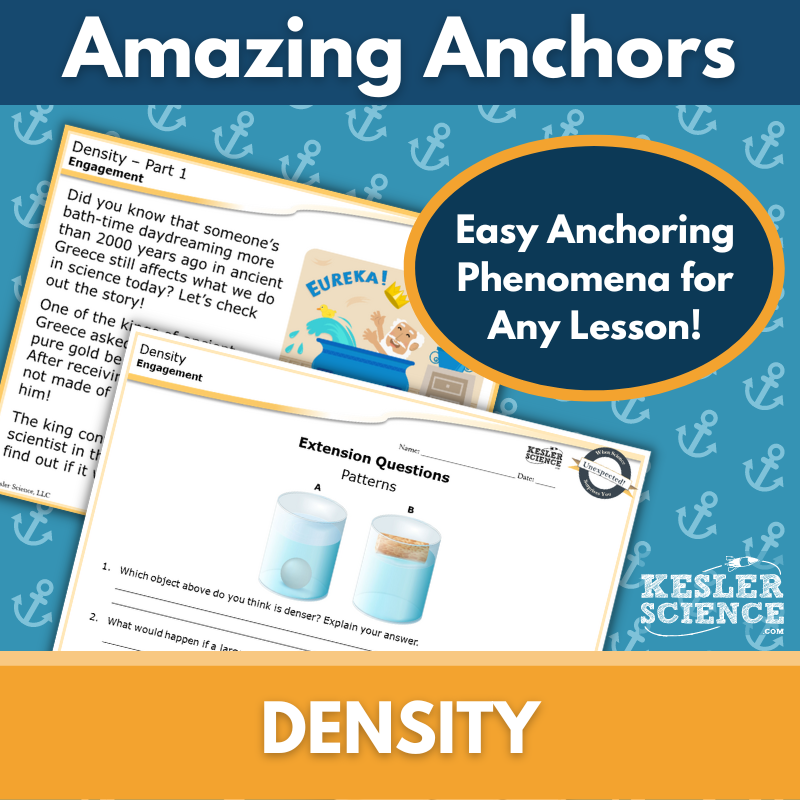Comparing Density Activities for Middle School Science
Explore and calculate density with this engaging 5E lesson designed for middle school students. The resources below will give students a comprehensive understanding of density. All of the following materials are also included in the Kesler Science Membership.
The Kesler Science Comparing Density 5E Lesson provides a comprehensive, engaging chemistry unit for middle school students to explore and calculate density. It includes editable presentations, worksheets, assessments, and student-choice projects, requiring minimal prep. The lesson supports differentiated, student-led learning with multimodal resources and Spanish translations, aligning with the 2021 TEKS 6.6D standard.
Following the 5E Model, students engage with vocabulary and class activities, then explore density through a hands-on, differentiated station lab featuring input and output stations. These stations incorporate reading passages, experiments, videos, and interactive activities to reinforce understanding. Editable PowerPoints and interactive notebooks guide the explanation phase, while elaboration allows students to extend their learning through choice projects. Evaluation includes STAAR 2.0-aligned assessments, review questions, and worksheets for discussion or homework.
Designed for flexibility, this lesson can be used in print or digital formats, making it ideal for both in-class and virtual learning.
The Kesler Science Comparing Density 5E Lesson provides a comprehensive, engaging chemistry unit for middle school students to explore and calculate density. It includes editable presentations, worksheets, assessments, and student-choice projects, requiring minimal prep. The lesson supports differentiated, student-led learning with multimodal resources and Spanish translations, aligning with the 2021 TEKS 6.6D standard.
Following the 5E Model, students engage with vocabulary and class activities, then explore density through a hands-on, differentiated station lab featuring input and output stations. These stations incorporate reading passages, experiments, videos, and interactive activities to reinforce understanding. Editable PowerPoints and interactive notebooks guide the explanation phase, while elaboration allows students to extend their learning through choice projects. Evaluation includes STAAR 2.0-aligned assessments, review questions, and worksheets for discussion or homework.
Designed for flexibility, this lesson can be used in print or digital formats, making it ideal for both in-class and virtual learning.
Engage your middle school students with this student-led station lab aligned to TEKS 6.6D, focusing on comparing the density of substances relative to different fluids. Designed for in-class or virtual learning, this interactive lesson promotes independent exploration while the teacher facilitates student learning.
Students engage with nine differentiated stations featuring hands-on activities, videos, readings, and research. They explore concepts through demonstrations, videos, and reading passages available in English and Spanish. They then demonstrate understanding by organizing information, sketching models, writing responses, and completing assessments. A bonus challenge station offers extension activities for advanced learners.
This low-prep, high-engagement resource encourages critical thinking and active learning in physical science.
Engage your middle school students with this student-led station lab aligned to TEKS 6.6D, focusing on comparing the density of substances relative to different fluids. Designed for in-class or virtual learning, this interactive lesson promotes independent exploration while the teacher facilitates student learning.
Students engage with nine differentiated stations featuring hands-on activities, videos, readings, and research. They explore concepts through demonstrations, videos, and reading passages available in English and Spanish. They then demonstrate understanding by organizing information, sketching models, writing responses, and completing assessments. A bonus challenge station offers extension activities for advanced learners.
This low-prep, high-engagement resource encourages critical thinking and active learning in physical science.
The Comparing Density Student Choice Projects align with the 2021 TEKS standard 6.6D, giving middle school students the opportunity to choose a project that matches their preferred output style. A project page outlines six student-led options plus a “design your own” project, all with an editable rubric for teacher, peer, or self-assessment. This resource is also included in the Comparing Density Complete Lesson for TEKS 6.6D.
These flexible, multimodal projects provide creative ways for students to demonstrate their understanding. Two versions of the project page support differentiation, with modified options for students needing remediation and challenge options for advanced learners. Teachers can adjust the rubric to fit grading needs.
The projects use standard classroom supplies like paper, markers, and scissors, and many options are available for digital completion.
The Comparing Density Student Choice Projects align with the 2021 TEKS standard 6.6D, giving middle school students the opportunity to choose a project that matches their preferred output style. A project page outlines six student-led options plus a “design your own” project, all with an editable rubric for teacher, peer, or self-assessment. This resource is also included in the Comparing Density Complete Lesson for TEKS 6.6D.
These flexible, multimodal projects provide creative ways for students to demonstrate their understanding. Two versions of the project page support differentiation, with modified options for students needing remediation and challenge options for advanced learners. Teachers can adjust the rubric to fit grading needs.
The projects use standard classroom supplies like paper, markers, and scissors, and many options are available for digital completion.
The Density Inquiry Lab aligns with TEKS standards, guiding students to calculate density to identify unknown liquids. Using small liquid samples, students measure mass, calculate density, and determine each liquid’s identity. The lab can be easily adapted by substituting different liquids as needed.
This resource includes three differentiated lab versions to accommodate diverse learning needs. The dependent student lab provides guided instructions with inquiry questions, the modified student lab offers a structured experience with simplified questioning, and the independent student lab allows students to take full control of the experiment. Editable pages, answer keys, and CER reflection questions support learning and assessment.
Students will work with materials such as gray clay, rubbing alcohol, vegetable oil, distilled water, glycerin, and honey. This hands-on lab engages students in scientific inquiry while reinforcing key concepts of density.
The Density Inquiry Lab aligns with TEKS standards, guiding students to calculate density to identify unknown liquids. Using small liquid samples, students measure mass, calculate density, and determine each liquid’s identity. The lab can be easily adapted by substituting different liquids as needed.
This resource includes three differentiated lab versions to accommodate diverse learning needs. The dependent student lab provides guided instructions with inquiry questions, the modified student lab offers a structured experience with simplified questioning, and the independent student lab allows students to take full control of the experiment. Editable pages, answer keys, and CER reflection questions support learning and assessment.
Students will work with materials such as gray clay, rubbing alcohol, vegetable oil, distilled water, glycerin, and honey. This hands-on lab engages students in scientific inquiry while reinforcing key concepts of density.
The Density Escape Room is an engaging, interactive activity where students apply their understanding of mass, volume, and density. Designed for flexibility, teachers can choose from eight independent puzzles, adapting the experience to fit various class lengths and student needs.
Students should be familiar with calculating density for both regular and irregular objects and know the density of water. The escape room can be conducted using simple materials like manila envelopes or a more immersive setup with locks and a storage box.
A digital version is available for online learning through PowerPoint or Google Slides, with a printable option for home use. The resource includes teacher directions, a detailed answer key, a digital answer sheet via Google Forms, editable templates, a video challenge, and printable props. Additional features include over 50 prize ideas, reward templates, and themed signs for a memorable classroom experience.
The Density Escape Room is an engaging, interactive activity where students apply their understanding of mass, volume, and density. Designed for flexibility, teachers can choose from eight independent puzzles, adapting the experience to fit various class lengths and student needs.
Students should be familiar with calculating density for both regular and irregular objects and know the density of water. The escape room can be conducted using simple materials like manila envelopes or a more immersive setup with locks and a storage box.
A digital version is available for online learning through PowerPoint or Google Slides, with a printable option for home use. The resource includes teacher directions, a detailed answer key, a digital answer sheet via Google Forms, editable templates, a video challenge, and printable props. Additional features include over 50 prize ideas, reward templates, and themed signs for a memorable classroom experience.
The Density Science Reading Comprehension Lesson helps students explore density calculations to identify unknown substances through a nonfiction article, comprehension questions, and an experiment testing density predictions. Designed for grades 6-8, the leveled passage supports science literacy and reading comprehension.
The resource includes two leveled articles (Lexile 1100-1300), five to seven comprehension questions, a hands-on mini-project, and a Cornell notes template. Engaging, printable graphics enhance the lesson, and the materials are compatible with virtual learning platforms like Google Classroom, MS Teams, Schoology, and Canvas.
Ideal for sub plans, extra credit, ISS, or whole-class instruction, this resource fosters critical thinking, classroom discussions, and textual analysis while reinforcing key density concepts.
The Density Science Reading Comprehension Lesson helps students explore density calculations to identify unknown substances through a nonfiction article, comprehension questions, and an experiment testing density predictions. Designed for grades 6-8, the leveled passage supports science literacy and reading comprehension.
The resource includes two leveled articles (Lexile 1100-1300), five to seven comprehension questions, a hands-on mini-project, and a Cornell notes template. Engaging, printable graphics enhance the lesson, and the materials are compatible with virtual learning platforms like Google Classroom, MS Teams, Schoology, and Canvas.
Ideal for sub plans, extra credit, ISS, or whole-class instruction, this resource fosters critical thinking, classroom discussions, and textual analysis while reinforcing key density concepts.
The Density Science Writing Prompt Activity engages middle school students in a creative skit or drama-based exercise to reinforce their understanding of density. Aligned with TEKS, this student-centered activity helps students calculate density to identify unknown substances while enhancing their science reasoning and writing skills. Designed for both in-person and virtual learning, it includes teacher directions with answer guides and rubrics, projection versions for classroom display or screen sharing, and both full-sized and half-sheet handouts with prompts, self-checks, and pre-writing strategies. A digital interactive version is also provided in PowerPoint, compatible with Google Slides.
Ideal for cross-curricular learning, pre-test assessments, student choice projects, extra credit, make-up work, and differentiation, this writing prompt fosters engagement and creativity. It can be displayed on bulletin boards or compiled into student anthologies. Because these prompts are designed for review, they assume prior knowledge or access to research materials.
The Density Science Writing Prompt Activity engages middle school students in a creative skit or drama-based exercise to reinforce their understanding of density. Aligned with TEKS, this student-centered activity helps students calculate density to identify unknown substances while enhancing their science reasoning and writing skills. Designed for both in-person and virtual learning, it includes teacher directions with answer guides and rubrics, projection versions for classroom display or screen sharing, and both full-sized and half-sheet handouts with prompts, self-checks, and pre-writing strategies. A digital interactive version is also provided in PowerPoint, compatible with Google Slides.
Ideal for cross-curricular learning, pre-test assessments, student choice projects, extra credit, make-up work, and differentiation, this writing prompt fosters engagement and creativity. It can be displayed on bulletin boards or compiled into student anthologies. Because these prompts are designed for review, they assume prior knowledge or access to research materials.
The WIKI Tickets© Formative Assessments provide engaging, flexible ways to check student understanding in 6th-8th grade science. This Chemistry Set includes 14 assessments, each available in five formats: a full-screen projection version, three print handouts, and a digital interactive version compatible with PowerPoint and Google Slides.
Aligned with NGSS and TEKS standards, these assessments cover key topics such as atomic structure, chemical changes, density, periodic table arrangement, and recognizing chemical reactions. Each standard has at least one ticket, with some topics featuring multiple assessments. A table of contents file is included to show alignment.
Designed for both in-person and virtual learning, WIKI Tickets© can be used as exit tickets, bellringers, or quick checks. Students can respond on paper, printed handouts, or digitally on their own copies of the interactive files. These colorful assessments provide a versatile, ready-to-use resource to gauge student progress effectively.
The WIKI Tickets© Formative Assessments provide engaging, flexible ways to check student understanding in 6th-8th grade science. This Chemistry Set includes 14 assessments, each available in five formats: a full-screen projection version, three print handouts, and a digital interactive version compatible with PowerPoint and Google Slides.
Aligned with NGSS and TEKS standards, these assessments cover key topics such as atomic structure, chemical changes, density, periodic table arrangement, and recognizing chemical reactions. Each standard has at least one ticket, with some topics featuring multiple assessments. A table of contents file is included to show alignment.
Designed for both in-person and virtual learning, WIKI Tickets© can be used as exit tickets, bellringers, or quick checks. Students can respond on paper, printed handouts, or digitally on their own copies of the interactive files. These colorful assessments provide a versatile, ready-to-use resource to gauge student progress effectively.
Lesson Extensions provide engaging, student-choice activities designed to challenge early finishers and deepen their understanding of chemistry standards. These activities help fill downtime, reinforce critical thinking, and keep students engaged with rigorous yet enjoyable learning opportunities. Aligned to NGSS and TEKS, they offer high-level enrichment for independent learners.
Each extension includes four interactive components: Puzzler for problem-solving, Maker Space for hands-on STEAM activities, Tech Connection for digital demonstrations, and Word Master for creative writing. Teacher directions, answer keys, projection versions for digital boards, and printable formats ensure easy implementation. Covering topics such as atomic structures, chemical reactions, the periodic table, and synthetic materials, these extensions provide a dynamic way to wrap up lessons and keep students actively learning.
Lesson Extensions provide engaging, student-choice activities designed to challenge early finishers and deepen their understanding of chemistry standards. These activities help fill downtime, reinforce critical thinking, and keep students engaged with rigorous yet enjoyable learning opportunities. Aligned to NGSS and TEKS, they offer high-level enrichment for independent learners.
Each extension includes four interactive components: Puzzler for problem-solving, Maker Space for hands-on STEAM activities, Tech Connection for digital demonstrations, and Word Master for creative writing. Teacher directions, answer keys, projection versions for digital boards, and printable formats ensure easy implementation. Covering topics such as atomic structures, chemical reactions, the periodic table, and synthetic materials, these extensions provide a dynamic way to wrap up lessons and keep students actively learning.
This Amazing Anchors Phenomenon Lesson engages students in learning about density through the discoveries of Archimedes. It includes an introductory reading with comprehension and extension questions to build foundational knowledge, followed by an explanatory reading that breaks down the science of density with additional reinforcement questions.
Designed to support any lesson on density, this no-prep resource includes teacher directions, answer keys, projection slides, and both print and digital formats for flexible classroom use. A modified version with sentence starters provides differentiation for student support. These readings serve as an engaging supplement to reinforce learning and are TEKS aligned.
This Amazing Anchors Phenomenon Lesson engages students in learning about density through the discoveries of Archimedes. It includes an introductory reading with comprehension and extension questions to build foundational knowledge, followed by an explanatory reading that breaks down the science of density with additional reinforcement questions.
Designed to support any lesson on density, this no-prep resource includes teacher directions, answer keys, projection slides, and both print and digital formats for flexible classroom use. A modified version with sentence starters provides differentiation for student support. These readings serve as an engaging supplement to reinforce learning and are TEKS aligned.
Year-Round Resources
These year-round activities will increase your students' understanding of many middle school science topics. All of these activities are also included in the Kesler Science Membership.
Visual Data & Graphing
You're not alone if your students struggle with understanding graphs, charts, and tables. It's a skill that takes an enormous amount of practice. This resource will help students build a strong foundation in analyzing data and creating their own data visualizations.
Bell Ringers and Warm-Ups
These middle school science bell ringers are an excellent way to engage your students as soon as they walk into your classroom. This comprehensive FULL YEAR resource includes everything you need to start off each science class with an interesting warm-up activity.
Review Board Games
Each game board has been carefully designed to keep students engaged. There are 10 different action spaces on each board and dozens of question cards. All of the actions are related to science concepts and keep the students motivated throughout the game.
Each game is ready to play. Simply print out the board and the cards and let the students enjoy reviewing nine different units.
Essential Questions and Standards
Below are the essential questions and standards associated with the lessons and activities included in the atoms unit. This topic is only one of more than 100 middle school science topics included in the Kesler Science Membership.
-
How is density of a substance calculated?
-
How does the density of substances compare to various fluids?
-
TEKS Science - 6.6D Comparing Density
Kesler Science Membership
Imagine never having to search for another middle school science lesson again. The membership gives you access to ALL of the Kesler Science products in one place (Yes, including everything above).
Say goodbye to long hours of lesson prep.

